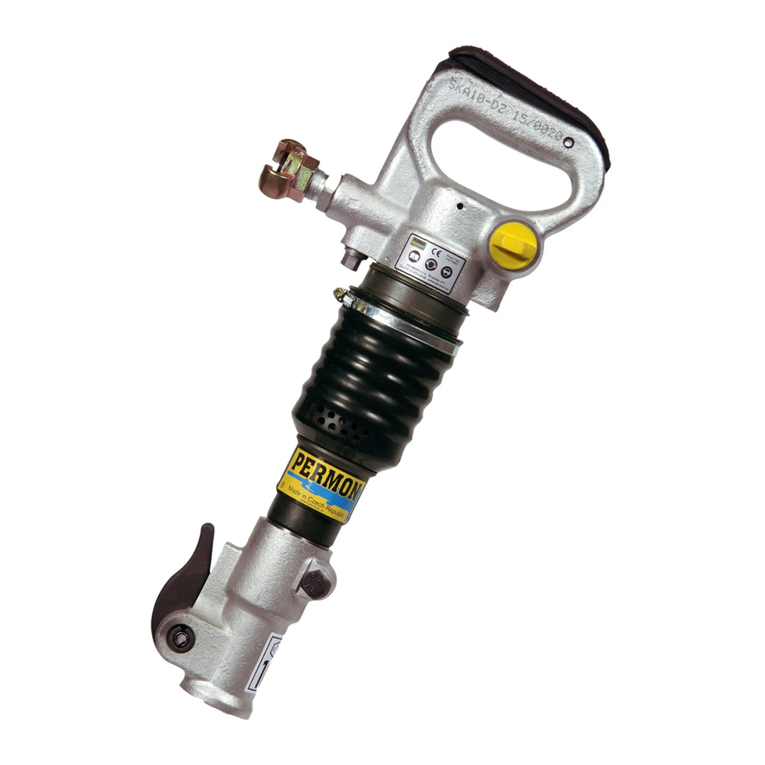
VK23 rock drill is designed for drilling through low to high strength materials in connection to an air leg. The
medium weight tool can be used for drilling holes during blasting operations in mines as well as on road
construction sites and other utility work. The recommended drilling range is 6 – 8 m with a diameter of 45 mm or
1 – 2 m with a diameter of 62 mm.
Permon is not responsible for any customer's modifications of tools for applications on which Permon was not
consulted.
PLACING TOOL IN SERVICE
• Always operate, inspect and maintain this tool in accordance with all regulations (local, state, federal and
country), that may apply to hand held/hand operated pneumatic tools.
• For safety, top performance and maximum durability of parts, operate this tool at 4 – 6 bar/400 – 600 kPa
maximum air pressure at the inlet with 1” (25 mm) inside diameter air supply hose. Apply the optimal thrust of
150 – 200 N.
• Keep the water flushing pressure at roughly 100 kPa less than the operating air pressure. The water
consumption is approximately 240 litres per hour.
• Always turn off the air supply and disconnect the air supply hose before installing, removing or adjusting any
accessory on this tool, or before performing any maintenance on this tool.
• Do not use damaged, frayed or deteriorated air hoses and fittings.
• Be sure all hoses and fittings are of the correct size and are tightly secured.
• Always use clean, dry lubricated air at 6 bar/600 kPa maximum air pressure. Dust, corrosive fumes
and/or excessive moisture can ruin the motor of an air tool.
• Do not lubricate tools with flammable or volatile liquids such as kerosene, diesel or jet fuel.
• Do not remove any labels. Replace any damaged label.
• Carrying out a check-up of the tool after 150 – 200 hours of operation is recommended.
USING THE TOOL
• Always wear eye protection when operating or performing maintenance on this tool.
• Always wear hearing protection when operating this tool.
• Keep hands, loose clothing and long hair away from the rotating end of this stool.
• Anticipate and be alert for sudden changes in motion during every start up and operation of any power tool.
• Keep your body stance balanced and firm. Do not overreach when operating this tool.
• Tool accessories may continue to impact briefly after throttle is released.
• Air powered tools can vibrate in use. Vibration, repetitive motions or uncomfortable positions may be harmful to
your hands and arms. Stop using any tool if discomfort, tingling feeling or pain occurs. Seek medical advice
before resuming use.
• Use accessories recommended by Permon.
• This tool is not designed for working in explosive atmospheres.
• This tool is not insulated against electric shock.
The use of other than genuine Permon replacement parts may result in safety hazards, decreased tool
performance, and increased maintenance, and may invalidate all warranties.
Repairs should only be executed by an authorised trained personnel. Consult your nearest Permon authorised
service centre.
SPECIFIC WARNINGS
• Always wear eye protection when operating or performing maintenance on this tool.
• Always wear hearing protection when operating this tool.
• Always turn off the air supply and disconnect the air supply hose before installing, removing or adjusting any
accessory on this tool, or before performing any maintenance on this tool.
• Do not use damaged, frayed or deteriorated air hoses and fittings.
• Air powered tools can vibrate in use. Vibration, repetitive motions or uncomfortable positions may be harmful to
your hands and arms. Stop using any tool if discomfort, tingling feeling or pain occurs. Seek medical advice
before resuming use.
• Do not carry the tool by the hose.
• Keep your body stance balanced and firm. Do not overreach while operating this tool.
• Operate at a maximum of 6.0 bar/600 kPa air pressure.
• When wearing gloves and operating models with an inside trigger, always make sure that the gloves will not
prevent the trigger from being released.
• Wear safety shoes, a hard hat, safety goggles, gloves, a dustmask and any other appropriate protective
clothing while operating the tool.


























